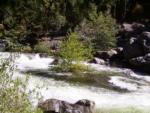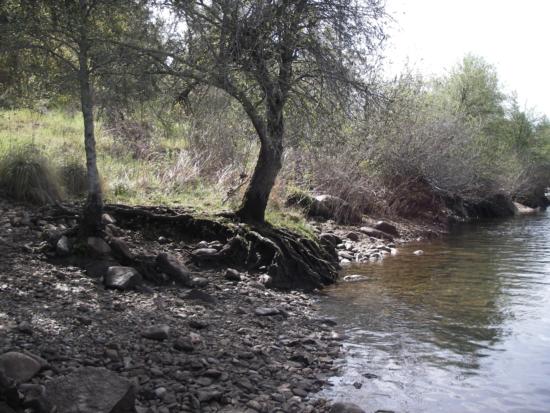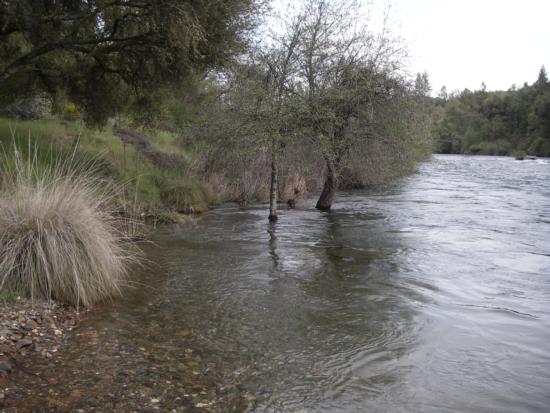Effects of Pulsed Flows from Dams on Fishes: Field and Lab Studies
-
IssuePulsed flows in rivers are relatively rapid increases in flows followed by relatively rapid decreases, with flow fluctuations lasting minutes, hours, or days. Reasons for pulsed flows include: generating electricity, flushing streambeds, facilitating human recreation, providing additional water for downstream diversion for irrigation, and preventing reservoirs from flooding. Although pulsed water releases provide obvious benefits to humans, the cumulative effects of repeated and unseasonal flow pulses on aquatic communities are relatively unknown.

-
Objectives
In this project we used an interdisciplinary approach, including telemetry, physiology, behavior, and experimental biology, in both laboratory and field settings, to study the response of fish to pulsed flows. This approach is consistent with recent suggestions that interdisciplinary research is essential to address complex fish biology processes such as movement and migration, and that telemetry is a tool that allows integration across disciplines and between the laboratory and field.
-
Research Activities
For this project we conducted several field and laboratory studies. Highlights of the studies are given below and in the Results section:
- We tracked the movements of radio-tagged domestic rainbow trout (Oncorhynchus mykiss) in response to frequent pulsed releases of water in the South Fork American River (California) from July to October 2005.
- We implanted rainbow trout with electromyogram (EMG)-sensor-equipped radio transmitters to assess the swimming behavior and associated energetic costs associated with their responses to pulsed flows. Using laboratory calibrations in a Brett-type swimming respirometer, the trouts’ swimming speeds and oxygen consumption rates were estimated for their in-river EMG data, through a complete hydroelectric power-generation river pulsed-flow sequence (pre-pulse, increasing flow, peak, and decreasing flow stages), on several sampling dates.
- We studied whether fish were displaced longitudinally downstream by a 1-day whitewater kayaking pulse flow release from Camino Dam on Silver Creek, a tributary of the South Fork American River, California.
- We studied whether juvenile fishes were able to maintain swimming speed and position during simulated river pulsed flows in a laboratory flume. We used a glass flume with river-rock substrate to determine the longitudinal displacement, movement distances and frequencies, velocity selection, and substrate use of juvenile hardhead Mylopharodon conocephalus, rainbow trout Oncorhynchus mykiss, and Sacramento sucker Catostomus occidentalis during a 100-min flow pulse, as velocity changed from slow to medium, fast, medium, and slow.
-
Results
- Our results suggest that the majority of hatchery rainbow trout released into the South Fork American River will not be washed downstream by repeated pulsed flows, and that most fish will remain in a home area within 3 km of their release site for several months, similar to trout in un-pulsed systems, unless captured by anglers or predators. We caution, however, that the ability of adult fish to maintain their position in the river does not necessarily imply that juvenile fish would have the same capability. Furthermore, the ability of trout to complete their life cycle, particularly spawning, egg incubation, and juvenile rearing, under the influence of repeated pulsed flows, was outside the scope of this study.
- In the EMG study, using a mixed-linear model, we found that fish swimming speed estimates increased during the increasing flow stage, while the associated mean oxygen consumption rates also increased at this stage. At river flows near the usual peak (>44 m3s-1), swimming speeds and movement rates decreased, possibly due to the fish using the river’s habitat complexities as hydraulic cover. We concluded that rainbow trout incur increased swimming-related energetic costs during increasing flows and, potentially, decreased foraging opportunities at high flows.
- In the study of the 1-day pulse on Silver Creek, our results suggest that most trout were able to remain in the study reach during the pulse, but that smaller fish may be more likely to be displaced downstream.
- In the flume study, fish were capable of maintaining swimming speed and position up to the maximum flume velocity of 0.46 m/s, except for one hardhead that impinged on the rear fish screen. Fish in the flume were able to use the rock substrate as hydraulic cover, decreasing the encountered water velocity, and, presumably, conserving energy.
-
Outcomes and Impacts
Our studies have provided improved information on fish biology in light of the re-licensing efforts underway and anticipated for numerous California dams. Our results have been presented at several multi-stakeholder workshops, at numerous fisheries conferences, and to the California Energy Commission. Results are also available as open-source peer-review publications.
-
Photos
 South Fork American River, Chili Bar Reach, at baseflow (~ 200 cfs), April 17, 2010 (taken from same vantage as photo below). Photo by Lisa Thompson.
South Fork American River, Chili Bar Reach, at baseflow (~ 200 cfs), April 17, 2010 (taken from same vantage as photo below). Photo by Lisa Thompson. South Fork American River, Chili Bar Reach, pulsed flow (~ 1,500 cfs), April 17, 2010 (same vantage as photo above). Photo by Lisa Thompson.
South Fork American River, Chili Bar Reach, pulsed flow (~ 1,500 cfs), April 17, 2010 (same vantage as photo above). Photo by Lisa Thompson. -
Supporting Information
Cocherell SA, Chun S, Cocherell DE, Thompson LC, Klimley AP, Cech JJ Jr. 2011. Lateral displacement and stranding of juvenile California stream fishes in a simulated pulsed-flow. Environmental Biology of Fishes http://dx.doi.org/10.1007/s10641-011-9894-z Download Request Reprint
Thompson, Lisa C., Sarah A. Cocherell, Stephanie N. Chun, Joseph J. Cech, Jr., and A. Peter Klimley. 2011. Longitudinal movement of fish in response to a single-day flow pulse. Environ Biol Fish 90(3):253-261. DOI: 10.1007/s10641-010-9738-2 Download
Chun, Stephanie N., Sarah A. Cocherell, Dennis E. Cocherell, Javier B. Miranda, Gardner J. Jones, Justin Graham, A. Peter Klimley, Lisa C. Thompson, Joseph J. Cech Jr. 2011. Displacement, velocity preference, and substrate use of three native California stream fishes in simulated pulsed flows. Environ Biol Fish 90(1):43-52. DOI 10.1007/s10641-010-9716-8 Download
Cocherell, Sarah A., Dennis E. Cocherell, Gardner J. Jones, Javier B. Miranda, Lisa C. Thompson, Joseph J. Cech Jr., A. Peter Klimley. 2011. Rainbow trout Oncorhynchus mykiss energetic responses to pulsed flows in the American River, California, assessed by electromyogram telemetry. Environ Biol Fish 90(1):29-41. DOI 10.1007/s10641-010-9714-x Download
Cocherell, Sarah A., Gardner J. Jones, Javier B. Miranda, Dennis E. Cocherell, Joseph J. Cech Jr., Lisa C. Thompson, A. Peter Klimley. 2010. Distribution and movement of domestic rainbow trout, Oncorhynchus mykiss, during pulsed flows in the South Fork American River, California. Environ Biol Fish 89(2):105–116. DOI 10.1007/s10641-010-9701-2 Download
Klimley AP, Cech, Jr JJ, Thompson LC, Hamilton S, Cocherell DE. 2011. Experimental and field studies to assess pulsed, water flow impacts on the behavior and distribution of fishes in the South Fork of the American River: Second Year. California Energy Commission, PIER Energy-Related Environmental Research Program. CEC-500-2009-067. August 2011, 83 p. DownloadKlimley, A.P., J.J. Cech, L.C. Thompson, S. Hamilton, and S.N. Chun. 2005. Experimental and field studies to assess pulsed, water-flow impacts on the behavior and distribution of fishes in California rivers, annual report, 2004-05. Prepared for the PIER Program Area, California Energy Commission. November 2005. CEC-500-2005-172. Download
-
Acknowledgements
This project was funded by the California Energy Commission.
-
For more information contact
Dr. Lisa C. Thompson
Wildlife, Fish, & Conservation Biology Department
University of California, DavisEmail: lcthompson@ucdavis.edu
Phone: (530) 754-5732



